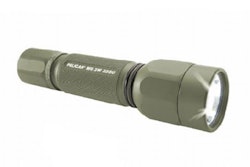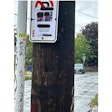When Tara Exposito, 14, went missing from her family home in Gulfport, Fla., in November 2002, officers at first considered her a runaway. Even when the skeleton of what was determined to be a small-framed, teenage girl was discovered in East Hillsborough, about an hour’s drive away, it wasn’t at first linked to Tara’s disappearance.
It took the perseverance of Det. Dale Bunten and the skill of forensic sculptor Wesley Neville, a lieutenant at the Florence County (S.C.) Sheriff’s Office, to link the remains to the girl.
First, Bunten sent the girl’s skull to Neville, a full-time certified forensic artist. Neville reconstructed the girl’s face, using markers and clay to flesh out her unique features.
“Upon completion of the reconstruction, I sent the package back to the Florida investigator in charge of the case,” says Neville. “Then, while searching through various missing persons Websites, I came across Tara’s photo, and the likeness was uncanny to that of the reconstruction that I had just completed. The investigators obtained DNA from Tara’s mother, submitted the sample to the FBI lab for analysis, and the match was confirmed.”
Another case that Neville worked on involved the skeletal remains of a man found in Tenille, Fla., in the summer of 2000. There were few leads until the bust that Neville had created using the man’s skull was spotted and linked to Larry Fishman, a 48-year-old man from New York who’d been missing since early 1999. Photos of the man bore a striking resemblance to Neville’s sculpture and a DNA match confirmed Fishman’s identity.
The C.S.I. Effect
The use of forensic art in police work is nothing new. Composite drawings have been part of police investigations for more than a century. Also age-progression drawings are often used to identify missing persons and fugitives who’ve been on the lam for numerous years.
The art and craft of forensic sculpting and three-dimensional imaging using a person’s skull, however, is a relatively new tool for law enforcement. Although the practice has been used for anthropological purposes for many years, it wasn’t until the mid-1970s that these techniques began to make their way into police work.
More recently, forensic sculpting received a burst of publicity when a team of forensic artists and anthropologists used CT scans to famously reconstruct King Tut’s face. In addition, the process has been featured in television shows such as “C.S.I.” and “Bones.”
A lot of criminal investigators and prosecutors bemoan the effect of these shows on the public. But some forensic sculptors say their effect has been good and bad.
“One of the best effects of the exposure of these TV shows is that young people are interested in science in a way they haven’t been before,” says Karen Taylor, author of “Forensic Art and Illustration” and a noted forensic artist. “And that’s giving kids a real-life application and example of physics and science, which facilitates learning. The downside is that we have some confusion about how certain things are done because of compressed time frames [on the shows] and there are also often increased juror expectations due to the media exposure.”
Media exposure is also increasing demand for forensic artists to assist in investigations. Consequently, more and more cold cases are now being investigated using facial reconstruction.
Seth Wolfson, forensic sculptor and author of the book, “Forensic Sculpting, Step by Step in Pictures,” worked on his first case after being contacted in 2004 by Det. Chris McMullin of the Bensalem (Pa.) Police Department.
Investigators found the decomposed body of a Caucasian woman behind a diner, and believed that she had been strangled a year or two before she was discovered. McMullin sent her skull to Wolfson, who crafted the woman’s face in clay, while Sgt. Danny Sollitti, a Jersey City, N.J., officer, worked on a two-dimensional illustration.
“We never looked at each other’s work because we wanted to make sure we were both doing it right,” says Wolfson, who also crafts prosthetics and does freelance artwork. “When we were done, we put it in Photoshop and looked at how each half connected, and it was pretty much on the money. There were a few little discrepancies here and there, but they’re to be expected.”
While the woman has yet to be identified, McMullin feels strongly that Wolfson’s facial reconstruction will be instrumental in solving the case, which was his first working with a forensic sculptor.
“We’ve gotten a lot of leads,” says McMullin. “Nothing has resulted in a match yet, but we’re still at it and I think the sculpture will definitely be key in identifying our victim.”[PAGEBREAK]
An Art and a Science
Like McMullin, more and more law enforcement personnel are now embracing the use of forensic sculpture, although the process still has an air of mystery about it. For example, some people believe that creating a face from a human skull is more about psychic ability than about formulaic equations. But forensic artists are quick to point out that their craft is a blend of both art and science, and that neither can exist without the other.
The science comes from the anthropological details of the skull and the bones themselves. Testing can determine the race, sex, and approximate age of the body. These factors are then used to determine the thickness of the muscles, skin, and tendons on the face and markers are placed over the skull, which allow the sculptor to flesh out the details.
These formulas can be very exact. For example, the shape of the nasal cavity yields many clues, including the length, width, and general shape of the nose. The teeth and gum ridges also attest to lip shape and form. In the end, the only body parts that are left to the artist’s discretion are the tip of the nose, the ears, and the hairstyle.
Ghosts in the Machine
“There is definitely a formula to the facial reconstructions,” says Neville. “Yet the artist always puts individuality or intuitiveness into his or her work.”
This is where the art of forensic sculpture becomes apparent, because in order to spark recognition and identification, there has to be a human-like quality to the bust. There has to be a hint of the person’s spirit and personality.
“Sure, you can get it to that point where it looks like a human head, but often it doesn’t look real,” says Wolfson. “That’s where the artistic nature comes in; just knowing how things should fall, what looks good and what doesn’t, so that it doesn’t look like a mannequin.”
Most forensic sculptors note that their work is not a quantitative science: Drawings and sculptures don’t produce something as measurable as a fingerprint. And they also know that there’s more to recreating a human face than numbers and rulers and markers.
“It’s fine art and it’s medical and it’s anatomical; a merging of science, law, and the fine arts,” says Barbara Martin, a certified forensic artist with the Oakland County (Mich.) Sheriff’s Office. She, like most in the field, works hard to encapsulate the personality of the person behind the face.
“That’s what Leonardo da Vinci and Michelangelo tried to do,” Martin says. “It’s the spirit and the essence of that person, their soul, the eyes looking back out at you, and that’s what I’m trying to capture.”
Frank Bender, a well-respected forensic sculptor and fine artist whose cases have been profiled on Court TV, “America’s Most Wanted,” and “60 Minutes,” takes that philosophy even further, relying less on scientific markers and more on artistic intuition when trying to flesh out facial characteristics. Calling himself a “recomposer of the decomposed,” Bender tries to interpret the mindset and lifestyle of the people he sculpts, so he studies all aspects of the case when doing a reconstruction.
“I always ask a bunch of questions, like what was found with the body,” Bender says. “And I spend a lot of time analyzing the crime scene and whatever other clues might be available.”
In the case of 18-year-old Rosella Atkins, whose skeletal remains were found behind a high school in North Philadelphia many years ago, Bender discovered one of the keys to her personality in a simple pleated blouse.
“That stuck out in my mind, “ he says, “because the fact that she was young and wearing a nice, pleated blouse, not a trendy t-shirt, told me that she was looking for a better life. So I sculpted the head with her looking up as though she were looking for hope.”
Bender’s intuition was evidently dead on. When Rosella was eventually identified, Bender says that several of her relatives commented on how she always tended to look upward, just as Bender had sculpted her.
Helping Law Enforcement
Even though the use of forensic sculpture has become more mainstream, it’s still often underused in police investigations. The reason is money. Budgets are tight, and departments simply can’t afford to hire extra personnel. Because of this, some officers choose to go into the field themselves.
“I found the need to have good sketches in my own cases,” says Sgt. Don Stahl of the Charles County (Md.) Sheriff’s Department in La Plata. “And since I had an art background, the idea occurred to me that maybe I could do it myself.” He has since worked on two facial reconstruction cases—one 3D computer rendering and one sculpture—and has discovered that there is more to the process than he had originally thought.
“There were interviews and other aspects of the process that needed to be fine-tuned,” Stahl says. “Plus the sculpture took about 10 days from the time I received the remains because I had to clean it and then reassemble it. In some cases, the mandible will separate from the upper part of the skull or the teeth will fall out post mortem. So it takes a lot of work to get the skull ready for a reconstruction.”
In addition to law enforcement personnel and freelance civilian forensic artists, there are also two organizations that can greatly aid law officers in their quest to identify bodies, find missing persons, and track and apprehend fugitives.
The Doe Network strives to “give the nameless back their names and return the missing to their families” and works primarily on cold cases from North America, Australia, and Europe. The pictures on the network’s Website allow both law enforcement and civilians to search for missing persons and it has an extensive network of volunteers who actively search newspapers and the Doe databases to try to match names and faces to actual people.
Project EDAN (Everyone Deserves A Name) was launched in 2001 as an offshoot of the Doe Network. More than a dozen forensic artists donate their time, energy, and exceptional skill to this organization, which helps police departments across the world bring closure to cold cases and shed new light on fresh cases.
Agencies interested in procuring the services of either agency can peruse the missing persons database at the Doe Network at www.doenetwork.org or request help from a forensic artist by contacting Project EDAN at www.projectedan.us.[PAGEBREAK]
Martin, who has spent more than 37 years as a forensic artist and has worked on many high-profile cases, feels strongly about volunteering with Project EDAN.
“I hate the thought that we have people, John and Jane Does, that just go in a box,” she says. “Into the ground they go, and nobody cares after that. Each of these people is a person, especially on cold homicide cases. If it was me and I was faceless, I would want somebody to give me my face back. And that’s the one thing I can do; I can give them back their face.”
Kelly Kyrik is a freelance writer who lives in Colorado. She is a frequent contributor to Police.
Intuitive Forensics
Frank Bender is a bit of an anomaly in the field of forensic art. Completely self-taught and armed with only a high-school education, he’s forged a 30-year career and garnered one of the highest identification rates in the business by using more “art” than “science.”
“When you speak in terms of forensics,” he says, “you speak in terms of averages and charts and scientific proof. Yet in art school you speak about the harmony of form. So, it’s really two totally different worlds.”
Bender usually uses markers as a starting point, but after that he goes on gut instinct. For example, one skull that he worked on had no nasal cavity, orbits, cheekbones, or upper jaw, but Bender was able to craft the face (and make the identification) anyway.
“As an artist,” he says, “I just kept working at bringing it forward from the back. I ignored the forensics aspect of it and kept going until I felt I had artistic harmony.”
Instinct prevailed over science in one of Bender’s earliest cases, as well. After sculpting the reconstruction of a little girl, he realized he didn’t like his creation and ended up agonizing over the bust for days, wondering how best to change it to make it “right.” Finally intuition took over.
“I had a dream where I was walking down a corridor,” he says, “and at the end of the hallway was a gurney. Suddenly this little girl with two pigtails sat up and smiled at me.
“I said, ‘That’s her.’ I sculpted it the next day, put it in the paper, and got her identified.”
















